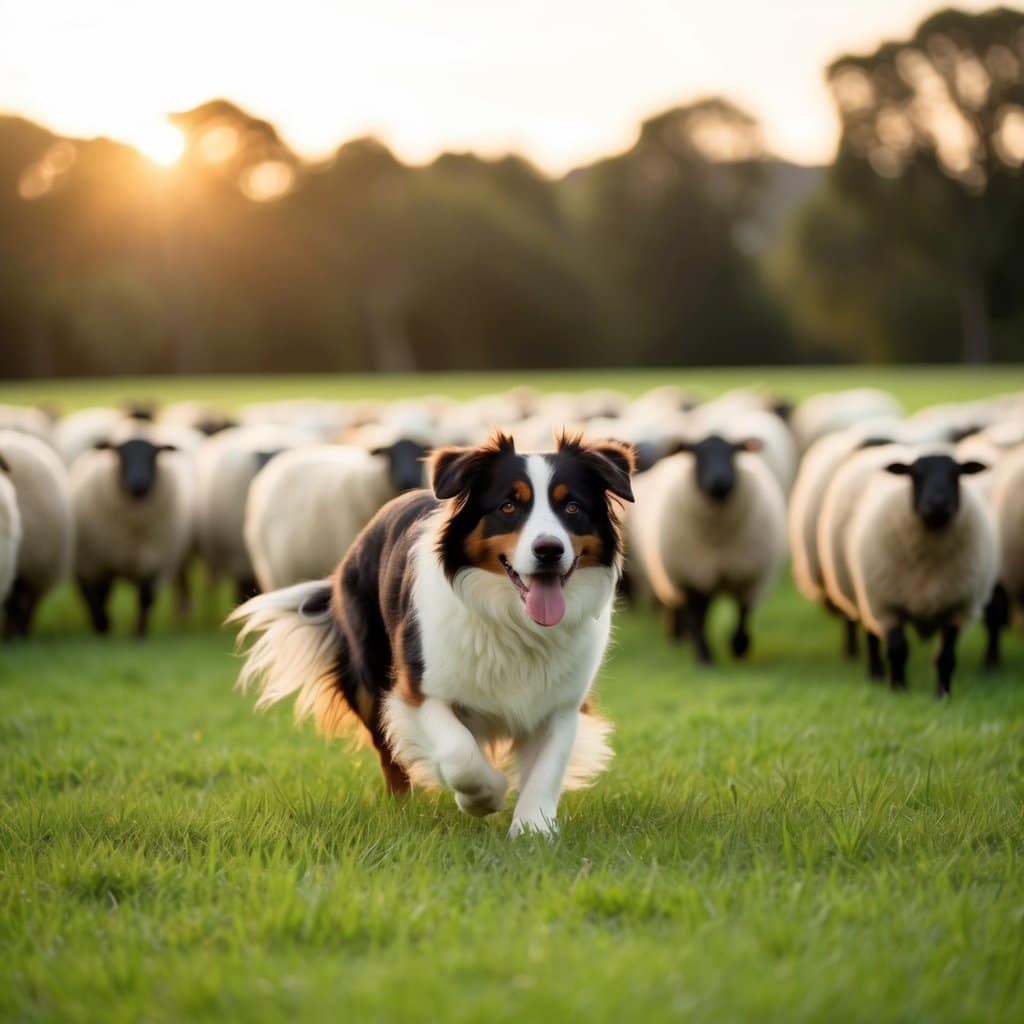
The Australian Shepherd, often called the Aussie, is a highly intelligent and active breed known for its vibrant personality. These dogs have a fascinating history, despite what their name suggests.
Originally bred in the United States, they were designed for herding livestock and have since become popular companions and work dogs.
A key thing to know about Aussies is their loyalty and strong work ethic, which makes them excellent choices for active families or individuals.
Their intelligence requires mental stimulation, so it is essential to provide them with activities that challenge their minds.
You will find them eager to please, which makes training them a rewarding experience.
Owning an Australian Shepherd means you’re in for a lifetime of adventure and companionship.
Their grooming needs are moderate, and they come with a thick double coat that requires regular maintenance. Aussies are generally healthy, with only a few breed-specific health concerns you should be aware of.
Key Takeaways
- Australian Shepherds are intelligent and active.
- They require mental and physical stimulation.
- Regular grooming and care are essential.
History and Origin of the Australian Shepherd
The Australian Shepherd, despite its name, was primarily developed in the United States. It has roots in the Basque region of Spain and gained popularity in California.
This breed became associated with Basque shepherds who brought their herding dogs through Australia to America.
Origins in the Basque Region
The origins of the Australian Shepherd trace back to the Basque region of Spain. Basque shepherds were known for their excellent herding dogs.
These dogs were skilled and adaptable, essential traits for managing livestock.
When the Basque people migrated with their sheep, they often brought these beloved dogs along.
Their journey across different lands contributed to the diverse gene pool of what would become the Australian Shepherd.
You can find more detailed information about their origins on the Australian Shepherd Wikipedia page.
Development in the United States
As Basque shepherds arrived in the United States, especially in the 1800s, their dogs began to evolve.
The breed we now recognize as the Australian Shepherd developed exclusively in the U.S.
The American influence added resilience and versatility to the breed.
Their skills were particularly valued in the western parts where cattle farming was prevalent.
The Australian Shepherd gained a reputation as an indispensable asset to ranchers.
The dog’s development was partly formalized with the creation of the Australian Shepherd Club of America, which recognized the breed in 1957.
Rising Popularity in California
In California, the Australian Shepherd saw a rise in popularity.
This state, known for its vast agricultural lands and livestock industries, provided an ideal environment.
These dogs became popular at rodeos, often recognized for their intelligence and agility.
As they participated in herding trials and exhibitions, their reputation grew.
They became not just working dogs but also popular companions.
The interactions with different livestock populations further refined their herding instincts.
Their adaptability made them a favorite among farmers and city dwellers alike in the region.
Detailed insights on their history in California can be explored from iHeartDogs.
Breed Overview and Characteristics

Australian Shepherds are known for their agility, intelligence, and energetic nature. You’ll discover their unique appearance features, common color patterns, and typical temperament traits below.
Defining Features of Appearance
Australian Shepherds are medium-sized dogs with an athletic and agile build. They typically stand about 18-23 inches tall at the shoulder.
Their distinctive medium-length coat can be straight or slightly wavy, providing protection in various climates.
Ears are often semi-erect, leading to an attentive look.
One striking feature is their eye color; eyes may be blue, brown, or even mismatched.
Some Aussies have a naturally bobbed tail, while most have longer ones. Their overall strong structure showcases their herding background.
Common Color Patterns
Australian Shepherds come in a variety of beautiful colors. The most common patterns include blue merle, red merle, and solid black or red.
Many have distinctive white and tan markings on their chest, legs, and face.
Each dog’s coat pattern is unique due to the merle gene, leading to an eye-catching appearance.
Young Aussies may have darker coats that lighten with age. These variations make each Aussie visually distinct, adding to their charm.
Typical Temperament
Aussies are highly intelligent and energetic, known for their problem-solving skills. They thrive on mental stimulation and physical exercise.
These dogs are devoted to their families and often show an intense loyalty.
You might notice their alert nature, always ready to react to changes in the environment.
As family dogs, they are protective and like being involved with family activities.
While friendly, they can be reserved around strangers, reflecting their herding instincts. This combination makes them both affectionate and watchful companions.
Health and Genetic Issues

Australian Shepherds, often known as “Aussies,” face several health challenges.
Common health issues include hip dysplasia, epilepsy, and eye problems. Understanding these conditions helps in providing better care.
Regular vet check-ups and preventive measures can reduce the risk of these problems.
Common Health Problems
Hip dysplasia is a frequent condition in Aussies, where the hip joint doesn’t fit together perfectly. This can lead to arthritis and pain.
Elbow dysplasia is another joint issue to watch for.
Eye problems, including cataracts and progressive retinal atrophy, can affect vision and require early detection to manage properly.
Epilepsy is a genetic disorder seen in Aussies. Seizures can vary in severity and need a vet’s attention.
These dogs may also have sensitivity to certain drugs, making medication choices important.
Regular screening and early diagnosis are critical in managing these health problems effectively.
Preventive Measures and Care
Preventive care plays a vital role in maintaining your Australian Shepherd’s health.
Regular veterinarian visits are important to catch any issues early.
Screening for hip and elbow dysplasia can help in taking timely actions.
Breeders who perform genetic testing on parent dogs often produce healthier puppies.
Keeping your Aussie active helps maintain a healthy weight, reducing joint stress.
Eye screening checks can catch problems before they worsen.
A balanced diet rich in essential nutrients supports overall health.
Avoiding high-risk activities and providing a safe environment lessens the chance of injuries.
Regular grooming and dental care also contribute to your dog’s well-being.
Training and Exercise Needs

Australian Shepherds are known for their intelligence and high energy levels. To keep them happy and well-behaved, you need to focus on both mental and physical activities.
Proper training and exercise can help your Aussie thrive in an active family environment.
Training for Intelligence and Obedience
Australian Shepherds are highly intelligent and eager to learn.
Training them for intelligence exercises is crucial.
Their natural trainability makes them easy to train, but it’s important to start with early socialization.
This helps them to be well-rounded and reduces behavioral issues.
Basic obedience training is also necessary.
Teach commands like “sit,” “stay,” and “come.”
These dogs excel in activities like agility and obedience trials provided by the AKC.
Training sessions should be short but frequent.
Aussie Shepherds respond well to positive reinforcement techniques, such as treats and praise.
Keeping their mind active prevents boredom, which often leads to unwanted behavior.
They also enjoy puzzle toys and tasks that challenge their problem-solving skills.
Exercising a High Energy Breed
Known for their high energy levels, Australian Shepherds need more exercise than many other dog breeds.
They require at least 1 to 2 hours of exercise daily.
You can split this into two sessions: one in the morning and one in the evening.
Activities can include running, hiking, or playing fetch. Make sure to engage not only their bodies but also their minds.
Aussies love activities like agility courses, which can improve their physical and mental health.
Since they are bred as working dogs, their exercise needs are significant to maintain happiness and health.
For active families, involving your dog in family activities, like cycling or jogging, can be highly beneficial.
Grooming and Maintenance

Australian Shepherds have beautiful coats that require consistent attention to maintain their health and appearance. Regular grooming and managing shedding are crucial to keeping their coat in top condition.
Dealing with Shedding
Australian Shepherds are known for their shedding, which can be quite noticeable.
These dogs have a double coat consisting of a dense undercoat and a longer outer coat.
Daily brushing is essential to control shedding and prevent mats from forming. Use a slicker brush or an undercoat rake to help remove loose fur.
Shedding can increase during seasonal changes, typically in spring and fall.
Regular baths will not reduce shedding but can keep the coat clean and manageable. Post-bath brushing helps effectively remove shed fur.
Routine Grooming Tasks
Routine grooming goes beyond just dealing with shedding. To maintain the health of your Aussie, focus on essential tasks.
Brushing a few times a week helps prevent mats and tangles.
Bathing is recommended every few months, or as needed, to keep the coat clean.
Pay attention to areas prone to tangling, like behind the ears and around the legs.
Keep an eye on their coat color and texture for changes, as this might indicate health issues.
Regularly check and clean their ears, trim their nails, and brush their teeth for overall health.
Frequently Asked Questions
Australian Shepherds and Cattle Dogs are popular breeds known for their energy and intelligence. Understanding their exercise needs, coat colors, potential health issues, living conditions, size differences, and grooming requirements can help you care for them better.
How much exercise does an Australian Shepherd need daily?
Australian Shepherds are active and energetic dogs. They require about one to two hours of exercise each day.
This can include walks, playtime, or agility training to keep them healthy and happy.
What are the distinct coat colors available in Australian Cattle Dogs?
Australian Cattle Dogs, often called Blue Heelers or Red Heelers, typically have two main coat colors: blue and red.
The blue coat is a mixture of black, gray, and white hairs, while the red coat features a blend of red and white hairs.
Can Australian Shepherds adapt well to apartment living?
While Australian Shepherds thrive in homes with ample space, they can adapt to apartment living if given enough exercise and mental stimulation.
It’s crucial to ensure they have plenty of activities to prevent boredom.
What are the common health concerns associated with Aussie dog breeds?
Aussie breeds, like Australian Shepherds and Cattle Dogs, may face health concerns such as hip dysplasia, eye disorders, and epilepsy.
Regular veterinary check-ups can help in early detection and management of these issues.
How do Mini Australian Shepherds differ in size compared to standard Australian Shepherds?
Mini Australian Shepherds, also known as Miniature American Shepherds, are smaller versions of the standard Australian Shepherd.
They typically weigh 20 to 40 pounds, compared to the 40 to 65 pounds of a standard Australian Shepherd.
What grooming requirements are typical for an Aussie dog breed?
Aussie dog breeds generally have moderate grooming needs. Regular brushing helps manage their thick coats and reduces shedding.
Bathing should be done as needed, and it’s important to check their ears and trim their nails regularly.
Proper grooming can prevent issues related to their coat and skin.





